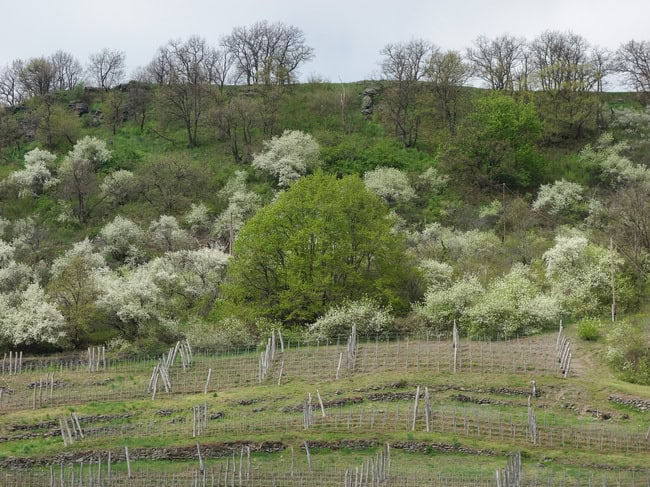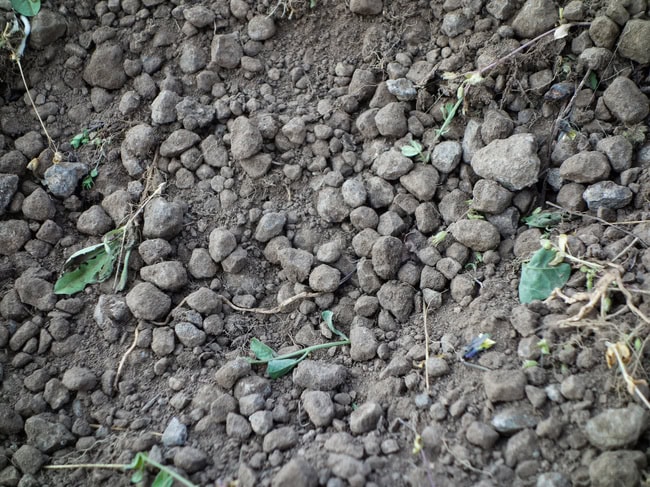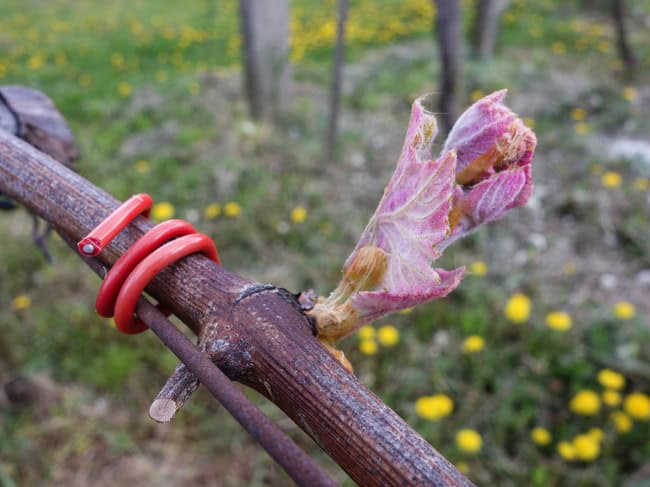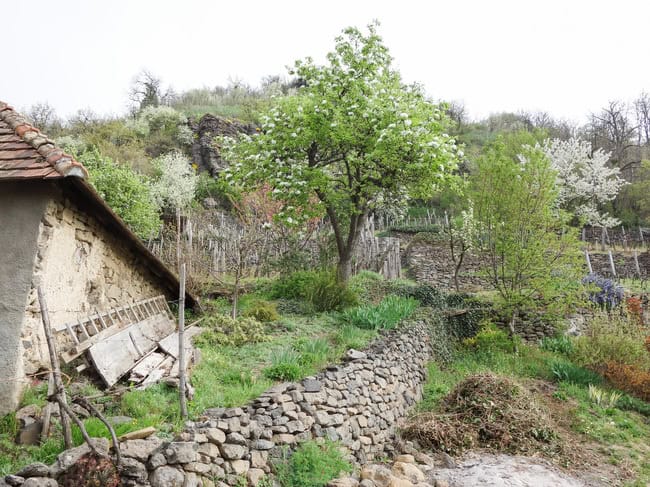I was on my third day in paradise when I had one of those flashes of insight that wine writers constantly pray for.
I’d been lulled into a meditative state by the excesses of spring that gently assaulted me in this far corner of the Hungarian countryside. Technicolor birdsong rippled through the air, dodging and weaving between the boughs of cherry and plum bursting into blossom above the vines, who were themselves beginning to unfurl the first downy pink leaves of their new vintage. A riot of tulips, buttercups, and dandelions swayed in the light breezes tugging at the fresh grass between the rows of new growth.
Several times each day I found myself wanting to simply wander away from wherever I was and lie down in the shade of an apple tree until nightfall. My guard wasn’t just down, it had completely vaporized. While my analytical functions were still operating at the level required to take notes on the wines I was tasting and the people who made them, the rest of me was in full reverie. If I had any New Age hippie left in me, I would almost certainly be talking to you about some sort of electromagnetic vortex that surrounds the wine region known as Somló. Instead, I’ll simply say I was in the grip of an atmosphere more serene than I’ve experienced in a long time.
That’s when I realized the most astonishing thing about the wines that I had been tasting for the past three days. They all tasted like water.

The Origins of a Journey
In 2012, when I was invited to be a judge for Hungary’s Pannonhalma Wine Awards, my experience with Hungarian wines was limited. I had only enjoyed a few Tokaji Aszú dessert wines and a taste of dry Furmint courtesy of an adventurous sommelier in New York. I accepted the invitation to judge with the hopes of getting a quick education in what the country was capable of doing, and that’s exactly what I experienced while tasting a few hundred wines over a couple of days.
At one point on the afternoon of the first day of tasting, a wine was poured into my glass that resembled none of the previous wines. It smelled like pollen and tasted like sunshine filtered through a clean mountain stream. It made me smile, and even giggle. I almost certainly dropped the f-bomb with glee.
One of the greatest pleasures of exploring the world of wine comes in the form of a wine that, from out of the blue, eclipses the world around you — shrinks your attention to the immediacy of what is in your glass — and makes the fireworks go off on your palate.
That’s what my first taste of Juhfark did to me, and I’ve been obsessed with it ever since. Had I been more impulsive, and less considerate of the work that had gone into planning the itinerary that was to follow the competition, I would have immediately headed off to find out where this wine came from and how many more like it existed in the world.
Instead, I was left to dream of a place called Somló and to plot my eventual pilgrimage to the homeland of Juhfark. It took four years, but this spring I finally I made it.

Volcanic Wine
The tiny hill of Somló is one of Hungary’s smallest wine regions, and one of the world’s most unique. It belongs to an exclusive group of locations around the globe that are wholly volcanic (think Santorini, the Canary Islands, Mount Etna, etc.). Which is to say that the grapes grow in soil that is heavily, if not entirely, made up of ash or various extrusive igneous rocks (a technical term for rocks formed from cooling lava that has emerged out of a volcano).
Sticking up off the Pannonian Plain like a loaf of bread on a tabletop, Somló was itself once a volcano, but of a very particular sort. Ten million years ago it sat a hundred meters or so beneath the surface of the shallow Pannonian Sea.
The little volcano (or more accurately three separate undersea vents) that became Somló bubbled there underwater for some time, spewing out enough molten laval to make a bump that today rises 1427 feet (435 meters) off of the plain. In addition to lava, this volcano bubbled up more than its share of gasses. These penetrated the cooling rock, making for what is today a relatively crumbly, coarse grained form of basalt. For the last 5 million years or so, this stone has been eroding into the famous “buckshot” soils that cover the lower slopes of the hill: a mix of pea-sized basalt pebbles, sand and loess (the fancy name for windblown dirt). The higher on the hill, the more basalt. The lower on the hill, the more loess.

Planted around the entire 360 degree circumference of the hill in a patchwork of tiny plots, grapevines dig deep into the volcanic rock. Some are buttressed by steep terraces that climb right up to the exposed basaltic columns known locally as the “stone kitchens’ which form the escarpment that gives the hill its loaf-like, or some say hat-like shape.

A Region Unto Itself
At merely one kilometer across and about 1.5 kilometers long, the hill of Somló takes about 20 minutes to circumnavigate in a car, even with the zigzags inevitably forced upon you by the narrow and irregular lanes that make up the complete circuit. From most places around the circuit, you can see the ruins of the Somlói Var, a 14th Century royal castle that in later centuries became a fortress for feudal militia.
Though it has lost the title of Hungary’s smallest wine region to the even tinier Pannonhalma appellation, Somló consists of a mere 1199 acres (485 ha) of vineyards, planted mostly to Juhfark, Olaszrizling, Furmint and Hárslevelű. These latter two grapes are, of course, the primary grapes of the Tokaj region, but in Somló they manage to achieve an identity all their own. Olaszrizling (known in English as Welshriesling and completely unrelated to Riesling) also features prominently in many places around Hungary but especially in the wine regions around Lake Balaton. Juhfark (which means “sheep’s tail,” — so named because of the shape of its clusters) however, comes only from Somló.

As in most regions of Hungary, these grapes are dry-farmed, and benefit from the milder, drier weather that the hill seems to produce due to its height and relative isolation on the plain. Winemaker after winemaker told me stories of how, during rainstorms, there will often be clear skies above Somló, and the hill will escape the bulk of the rains that fall on the surrounding areas.
Humidity remains a major factor in farming however, and botrytis, the “noble rot” responsible for sweet Tokaji wines, often plays a role in the Somló wines, despite the general lack of late harvest wines made on the hill.
Despite its small size, the hill is farmed by a staggering 1204 individual wine producers, a number I know only because I met the guy whose responsibility it is to keep track of them all for the government. Of those 1204 farmers, only 42 of them are registered to sell bottled wine with a label on it. A few dozen make enough for the wines to be sold elsewhere in the country, and the number of those producers whose wines make it out of Hungary can be counted on two hands with fingers to spare. There are only two producers of any size on the hill — Kreinbacher and Tornai, both of whom have large, modern cellars that wouldn’t be out of place in Napa or any modern wine region. The other 40 cellars fall on a spectrum somewhere between minuscule and tiny.

Take a walk early in the morning, with the mist rising off the fertile fields surrounding the hill, and you might catch a glimpse of the region’s migrating winegrowers. They pile off the local bus that picked them up in their villages several kilometers away. When the doors open, they clamber down, hoist their leather rucksacks of tools, and trudge up the hill to do their day’s work in the vines.
Though the hill is now dotted with small houses in and amongst the vineyards, virtually no one lives in them. They serve as weekend cottages, either to rest after a long day’s work in the vineyards, or for the family to picnic at during holidays. In part, this is due to the lack of infrastructure on the hill. Electricity is not universal, and all but a very few people rely on collected rainwater for taps, showers, and toilets. The only sources of clean drinking water are springs which bubble up from midway down the slope on either side of the hill.

An Outsized Reputation
For a little hill, Somló has a large history. Its crumbly, fast draining soils were recognized for their quality by the Romans. They planted the hill with grapes in the first and second centuries AD as the surrounding Pannonia province (and the entire Roman empire) flourished under emperors Hadrianus and Antoninus Pius. In the 11th century, the hill was divided among aristocratic families and the Royal Court itself. It was likely during this time that the wines were first shipped abroad to the rest of Europe.
By 1511 the hill’s vineyards were owned by the Somlóvásárhely nunnery, and governed strictly by the mother superior. Her published regulations for Somló included not only the earliest date for harvest and several specific regulations for winemaking, but also strict codes for behavior, lest the grapes suffer from immoral influence. Swearing was forbidden in the vineyards, as was malicious gossip, and, of course, any source of public indecency, especially drunkenness. Starting in September as harvest approached, only old ladies were allowed to guard the vineyards against theft, the combination of young women and ripe grapes being presumably too much for even the most upright citizen to resist.
The earliest documents that reference specific grapes grown on Somló date to the 8th century, and list three primary grape varieties: Juhfark, Furmint, and Sárfehér. These, and at least three others (perhaps including Olaszrizling and Hárslevelű which persist today) were planted — as were most vineyards before phylloxera ravaged the entire continent in the late 1800s — as a mixed field blend. Winemakers would harvest them all together to make a single wine of great renown. These wines were likely sweeter in the past than today, as the cooler, wetter climate would have encouraged the noble rot botrytis to lend its sweet signature to the harvest, but the most famous wines of the hill have always been dry.

Marked by exceptional levels of acidity, the wines of Somló were, even centuries ago, famously long lived. Records from the World Expo held in Hungary in 1898 show 20 or even 30-year-old vintages of Somló competing for prizes and available for tasting. Their ageability and sturdiness meant that the wines traveled well, and were known throughout Hungary and Europe.
I was told by more than one winemaker of the existence of a museum artifact — a bill of lading from a trans-atlantic trading voyage — that records Somló wines being shipped from a merchant by the name of Vince Ramassetter to the American colonies in the late 1700s. Unfortunately the museum where this artifact is supposed to live was recently closed for renovations, so I was unable to verify this to be true, but several locals swear up and down that it exists, and that Somló wines were among the very few still wines that could survive the vicissitudes of that lengthy sea voyage.
Somló’s wines were perhaps given their highest national recognition by a patron saint of Hungarian intellectualism, a philosopher named Bela Hamvas, who, in 1945 wrote what he described as “a prayer book for the atheists” entitled The Philosophy of Wine. In its 111 pages, he makes the claim that wine contains the very essence of spirituality, one that can actually be consumed. Hamvas had a special place in his heart for the “mountain wines” of Somló:
“The fiery wine of Somló is grown on volcanic soil… and has, for me, the last word of all of our wines…. For me Somlói is not only a solar bari-tone, but also a symphonic, blond, masculine wine, which, among our wines, contains, in a uniquely concentrated purity, the oil of the highest creative spirituality. Therefore I think that, although all wines require company and reveal their true nature when drunk in a community, Somlói is the drink of the solitary. It is so filled with the oil of the Creation’s intoxication that we may drink it only in a sufficiently immersed, definitely silenced, and balanced solitude. Incidentally, about Somlói (I speak of the original, ancient, today already scarce, almost white-gold, dry, and fiery Somlói) I would also say that, though all serious mountain wines are more appropriate to an age above forty than to youth, that Somlói is the wine of the very old. It is the wine of wise people, of those who finally have acquired the greatest knowledge – serenity… In the hieratic mask of Somlói I felt myself the closest to the ripe serenity and wisdom, to the intensive creative intoxication that brought this world into being.”

Over the years the Sárfehér grape faded into disuse (there are only a few rows that remain in existence), and plantings on the hill became more mono-varietal. Along the way Juhfark, highly prone to botrytis and somewhat finicky to grow, also became scarce enough that when the current appellation system was formed after the end of the Cold War, the Hungarian government didn’t even include Juhfark as an approved grape for the region. Outraged, the growers of Somló planted more. Eventually the government sued the growers of Somló. In what became the region’s wine equivalent of the Battle of the Marne, the growers triumphed, and Juhfark became instantly and forever synonymous with Somló.
No one is quite sure when or how (local conspiracy theories describe a drunken meeting of a few producers who concocted the idea) but Juhfark has also become famous for another reason. It is widely described in Hungary as the “Wedding Night Wine.” As legend has it, consuming a bottle of Juhfark on your wedding night increases the likelihood of conceiving a son. This modern legend offers no end of annoyance to many producers who believe Somló’s reputation should rest both on more historical merits and perhaps on the quality of their Furmint (which many believe does better than Juhfark on the hill), but no one seems willing to complain too much about the steady demand for Juhfark among their countrymen.
Water into Wine
A week spent tasting the wines of Somló goes down as one of the most idyllic wine journeys of my life. For five days I soaked in the pear, honey and white flower essences of Furmint; I basked in the liquid sunshine, melon and citrus of Hárslevelű; I was refreshed by the brisk brightness of Olaszrizling; and I fell deeper in love with the bee pollen, yellow herbs, and crystalline brilliance of Juhfark.
But mostly I marveled at the wonder that is Somló. I can honestly say there are few terroirs I have ever experienced that express themselves so strongly and consistently as does this little lump of rock in the middle of nowhere, Hungary. During my visit I tasted wines from nearly every commercial producer on the hill, and sampled vintages from many going back more than a decade.

In their youth, the wines of Somló are snappy and tight, brimming with acidity and the brightness of a new vintage, underscored by a distinct wet chalkboard or wet stone minerality. This is true even when they show characteristics of botrytis influence, a note desired by some winemakers and eschewed by others. Each grape variety ages differently, but quite consistently the wines of Somló put on flesh and heft in their first few years, filling out their lithe forms to become more broad-shouldered and expansive.
What happens next in their evolution, however, is nothing short of remarkable.
Like a murmuration of starlings wheeling together in unison, or a vast school of salmon all turning unerringly in the ocean and heading back to the stream of their birth, in time the wines of Somló begin to converge towards a single organoleptic location. Call it the strange attractor of Somlo — a flavor profile that proves to be the archetypal essence of what Somló wine represents.
It took me several days to fully understand what I was tasting in these older wines — as if I was one of those proverbial blind men feeling his way around an elephant. I had to piece together the trajectory of these wines one sip at a time.
But then one afternoon, walking down a little lane on the eastern side of the hill, I chanced upon one of the springs bubbling up from underneath the rock, and I stooped to cup my hand for a drink from a spiral hollow set with flagstones. The cool water tasted like it had been squeezed through pulverized rock. It was faintly chalky, distinctly alkaline, slightly savory, and, in terms of drinkability, utterly fantastic.

As I stood and watched a few glistening droplets fall off my fingertips onto the grass and flagstones below, I realized that the taste in my mouth was nothing less than that deeply mineral core to which every older wine I tasted seemed to be returning, regardless of what grape it had been made with. Indeed, what I have found, without exception, is that the older the Somló wine, the less it tastes like the grape it was made from and the more it simply tastes like Somló.
I’ve never quite experienced anything like this in all my years tasting wines around the world, and I found it profoundly moving. The distinct and powerful expression of place is something that serious wine lovers constantly seek, and the wines of Somló offer it with surprising singularity. If you want to know what Somlói really tastes like, all you have to do is take a deep draught of spring water from the heart of the hill.
No one quite knows where the water that feeds Somló’s springs comes from. Geologists have tried to puzzle out the exact source for years and failed. But somewhere there must be a natural basin, deep within the volcanic heart of the hill, gathering each season’s rains as they percolate down through the rock — a pristine aquifer sitting in some chamber formed perhaps by some massive gas bubble millions of years ago.
That the wines share their character with the water that has made two passages through this crumbly igneous soil comes as no surprise to a serious student of the grape. But the mechanism behind this reality continues to elude scientists, who have not yet found a pathway for mineral uptake by vines that definitively links the geologic character of a soil to a specific flavor in a wine. While they’re busy figuring it out, the rest of us can simply smile at the transparency of grape to place, and pour another glass of liquid stone.

The Next Little (Exclusive) Thing
Despite having the quality and distinctiveness to do so, Somlós wines will never stand in the spotlight in the way that Austrian Grüner Veltiner did in the Nineties, or the way the wines of the Jura have for the last five or six years, for one simple reason. There’s just not enough wine to go around. There are about 100 fewer acres of Somlo wines than there are acres of Grand Cru Burgundy. And only a minority of the acreage in Somló makes it into a bottle that gets sold, let alone exported.
Even if Blue Danube Wine (currently the primary importer of Somló wines to the US) brought in every single bottle available for export, that would still mean only paltry amounts for each major market in the country. So as much as I might fantasize about it, and as perfect a match as these wines are for the current trend towards eclectic, high-acid wines from obscure locales, Somló wines will not be taking the wine world by storm anytime soon.
Having said that, a week after I returned from Hungary, I happened to be dining at one of San Francisco’s hottest new restaurants, and there, poured by the glass no less, was a Hárslevelű from Bela Fekete, one of the oldest and most prestigious producers on Somló. That was certainly the first time I’ve seen a wine from Somló poured by the glass in the US, but I’m sure it won’t be the last. These wines will eventually become the secret weapons of the most savvy sommeliers, mark my words. They tick every box of the hipster sommelier’s fantasy wish list, and more importantly, they’re just damned delicious.
In the 8th Century, an earl by the name of Fekete (no relation to the aforementioned Bela) lived on Somló. He filled his leisure time by writing poetry and making wines, both of which he insisted on sending to his French acquaintance Voltaire. Legend has it that after several waves of poems and bottles, Voltaire penned a note of thanks to the Earl, which he closed with the quip, “if only you wrote poems as good as this wine.”
The wines of Somló are themselves a kind of primal poetry, one that reveals layers of meaning the closer you get to their volcanic heart. But just like the best poetry, you don’t have to really understand them to enjoy them. You can simply let them carry you away to a place where the loudest sound you hear is a chorus of songbirds, and the smell of green grass and fruit blossoms drifts by on the breeze.
Hamvas called them solitary wines, and I think I finally understand what he meant. For the longest time I never knew what people were talking about when they told me to find my happy place. But now I have.
